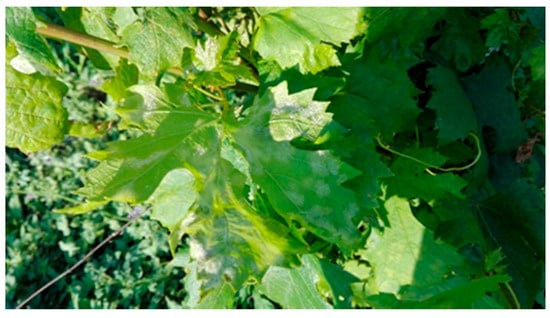Worldwide agricultural production is permanently threatened by the numerous fungi and phytopathogenic bacteria. These diseases are known to be caused by pathogens, such as fungi, molds, oomycetes, bacteria and viruses. Many of them, usually related to the climatic conditions, have dramatic consequences, leading to yield losses of crops, which can have a profound and sometimes catastrophic impact on the agricultural economy, especially when the disease reaches epidemic status.
Plasmopara viticola, responsible for the appearance of grapevine downy mildew is very common in our country and can lead to production losses of up to 80%. The disease attacks the grapevine on all the aerial organs such as leaves, flowers, bunches, shoots and grapes (Figure 1). Current treatments, based on synthetic biocides (inorganic copper salts, copper hydroxides, different organic compounds, etc.) have been used for long periods of time, and the pathogens have developed resistance. Modern fungicides have good efficiency, but they accumulate in plant organs, and are toxic for human consumption.

Figure 1.
Grapevine affected by downy mildew.
Due to concerns about the impact on human health and the environment, there is a growing demand for chemical pesticides to be replaced by ecological alternatives. In this respect, for the treatment of this disease, our group proposed a nanomaterial-based recipe, with no impact on the environment or human health, obtained from photosynthesized silver nanoparticles, using natural extracts. The large-scale production was achieved in 50 L reactors. The nanomaterials were characterized using UV-Vis spectrometry and X-ray diffraction, while the efficiency of the formulations was tested in greenhouse experiments.
The tested materials proved to be a very efficient antimicrobial agents, even when compared with commercial products.
Acknowledgments
This work was supported by a grant of the Romanian Ministry of Research and Innovation, CCCDI-UEFISCDI, project number PN-III-P1-1.2-PCCDI-2017-0332, contract 6PCCDI/2018, within PNCDI III and by Romanian Ministry of Research and Innovation -MCI through INCDCP ICECHIM Bucharest 2019–2022 Core Program PN. 19.23—Chem-Ergent, Project No. 19.23.03.01.
© 2019 by the authors. Licensee MDPI, Basel, Switzerland. This article is an open access article distributed under the terms and conditions of the Creative Commons Attribution (CC BY) license (https://creativecommons.org/licenses/by/4.0/).